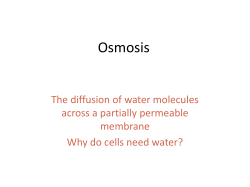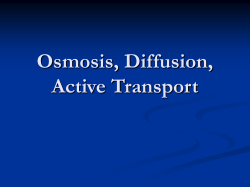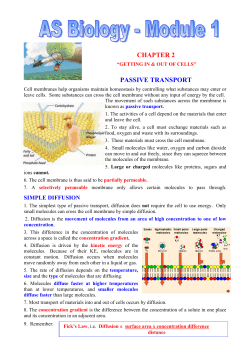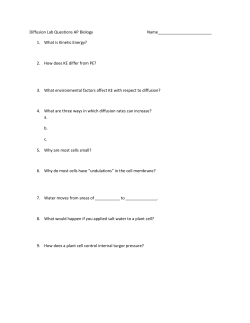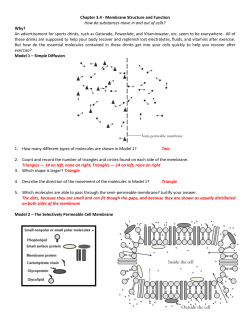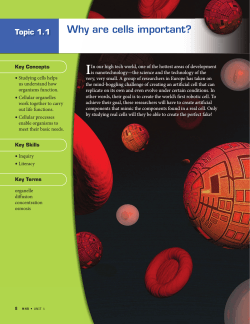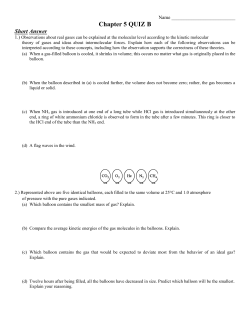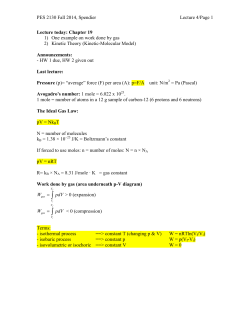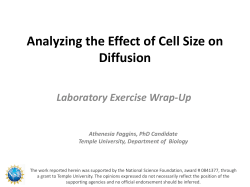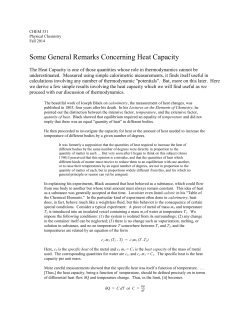
HOMEWORK WORKSHEET Cell Structure and Function Chapter 3.4-3.5 Section Assessments
HOMEWORK WORKSHEET Cell Structure and Function Chapter 3.4-3.5 Section Assessments 3.4 – Diffusion and Osmosis 1. Explain what a concentration gradient is and what it means for a molecule to diffuse down its concentration gradient. A concentration gradient is the difference in concentration of a substance from one location to another. A molecule diffuses down its concentration gradient by moving from a region of higher concentration to a region of lower concentration. 2. Explain why facilitated diffusion does not require energy from a cell. No energy is needed because the molecules move down a concentration gradient. 3. A cell is bathed it fluid. However, you notice that water is flowing out of the cell. In what kind of solution is this cell immersed: isotonic, hypotonic, or hypertonic? Hypertonic 4. How are receptors and transport proteins similar? Both are proteins and may work with only specific molecules. In addition, both may require a change in shape to accomplish their function. 5. When a person becomes dehydrated due to the loss of fluids and solutes, saline solution (water and salts) is infused into the bloodstream by medical personnel. Why is saline solution used instead of pure water? Pure water would be hypotonic relative to the contents of blood cells, so water would rush into the blood cells and could cause the cells to burst. The saline solution is isotonic relative to the cell contents. Power Notes 3.4 – Diffusion and Osmosis Sketch molecules diffusing into a cell Label the type of solution each red blood cell is in. Draw arrows on each cell to show the direction of osmosis. Sketch molecules entering the cell by facilitated diffusion Study Guide 3.4 – Diffusion and Osmosis Complete the concept map Free response Question 3.4 – Diffusion and Osmosis Suppose you have a container divided by a membrane that is permeable to water but not to sugar. Side A has a 10% sugar solution. Side B has a 40% sugar solution. Both start out at 10 cm in height. Over time, the height of one side drops to 7 cm, and the height of the other side increases to 13 cm. Which side of the container is now at 7 cm? Explain. Side A. The sugar cannot cross, but the water can diffuse. The water has a higher concentration on side A and a lower concentration on side B, so it diffuses from A to B Section Assessment 3.5 – Active Transport, Endocytosis and Exocytosis 1. How do transport proteins that are pumps differ from those that are channels? Pumps require energy; transport a molecule against its concentration gradient, and change shape upon binding. A protein channel does not change shape or require energy. It allows certain molecules to diffuse through it, down their concentration gradient. 2. How do endocytosis and exocytosis differ from diffusion? They require energy input, diffusion does not. They also enable larger particles to enter a cell, particles that are too large to diffuse across a cell membrane 3. Small lipid molecules are in high concentration outside a cell they slowly cross the membrane into the cell. What term describes this action? Does it require energy? Diffusion; no 4. These molecules in low concentration outside a cell. They move rapidly into the cell via protein molecules. What term describes this action? Does it require energy? Active transport; yes 5. Suppose molecules were unable to diffuse into and out of cells. How might life be different if cells had to use active transport to move every substance? Explain your reasoning. Cells would require vast amounts of energy to perform even simple functions. Perhaps organisms would have to take in more food to provide more energy. If food were limited, perhaps only photosynthetic organisms would be able to survive. Perhaps organisms would move and respond more slowly and be more sedentary. Perhaps organisms would be simpler, and highly specialized organs would not have developed. 22. How do transport proteins make it easier for certain molecules to diffuse across a membrane? Transport proteins can form a larger opening or pore that allows them to pass. 23. Under what conditions would a molecule need to be actively transported across a membrane? When the concentration of the molecule is higher on the other side of the membrane. 24. Do you think that endocytosis and exocytosis can occur within the same cell? Explain your reasoning. Yes, both are needed to move substances in and out of a cell and to maintain the cell's volume. Power Notes 3.5 – Active Transport, Endocytosis and Exocytosis Sketch molecules entering a cell by active transport What is endocytosis? It is the process of taking in or engulfing liquids or large molecules into a cell by means of a vesicle Sketch the process of endocytosis What is exocytosis? It is the process of releasing substance (such as a protein for example) out of the cell by the fusion of a vesicle with the cell membrane (plasma membrane) Sketch the process of exocytosis Study Guide 3.5 – Active Transport, Endocytosis and Exocytosis 1. What term means “cell eating” and describes a type of endocytosis? Phagocytosis 2. The prefix exo- means “out of,” and the prefix endo- means “taking in.” How do these meanings relate to the meaning of exocytosis and endocytosis? Exocytosis is a process that releases substances outside a cell. Endocytosis is a process that takes substances into a cell.
© Copyright 2025


